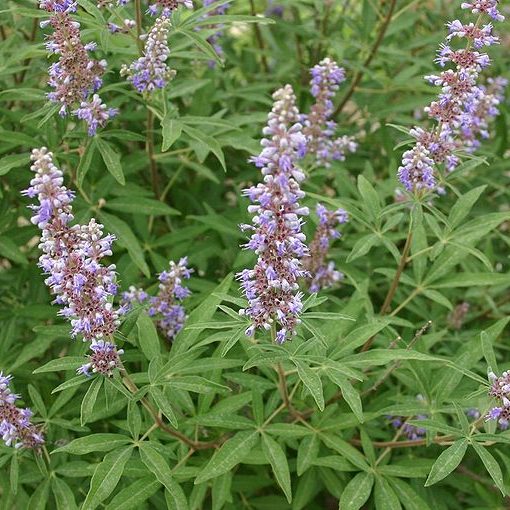Vitex is the #1 most prized herb for female fertility health. Vitex (Vitex agnus castus) is also commonly called Chaste berry or Chastetree berry. Have you ever wondered about that word, “chaste”? By definition “chaste” means, “abstaining from extramarital, or from all, sexual intercourse, or not having any sexual nature or intention.” Vitex got its name because, in ancient times, it was used to suppress female libido, particularly that of the priestess. Now, how did this herb once used to promote chastity become such a revered female fertility – including libido – enhancing herb? I guess the answer is simple; as a result of more concerted clinical use, knowledge of the hormonal system and HPA (hypothalamus-pituitary-adrenal axis) and science. There is apparently little evidence that vitex works in any way like an anaphrodisiac, but ample evidence exists indicating that it supports hormonal balance, a healthy luteal phase and progesterone production, reduction of PMS, and more.
Every day, women ask us: “Is vitex right for me?” In most cases, vitex provides amazing support as a part of a natural fertility program. It’s well tolerated by the overwhelming majority of women who use it and has few if any side effects. I wanted to share with you the top five benefits vitex can offer to help you choose if it’s right for your fertility needs.
Vitex Top 5 Female Fertility Benefits
1. Promotes a healthy, pain-free menstrual cycle with regular ovulation. Many women with fertility challenges have irregular cycles, painful cycles or problems with normal ovulation. Taken over time, vitex can support a more normal menstrual cycle. It’s especially helpful to rebalance the body after taking courses of fertility drugs or hormonal birth control.
2. Encourages the proper balance between estrogen and progesterone levels. Women we work with often have too much estrogen in relation to progesterone. Estrogen dominance can lead to a myriad of women’s health issues. (Learn more: Estrogen and Fertility- the Good, The Bad, and The Necessity) Vitex helps balance levels of luteinizing hormone (LH) and mildly inhibits follicle stimulating hormone (FSH). Through this unique action, it helps support a proper ratio of estrogen to progesterone through the different phases of the menstrual cycle.
3. Supports a healthy luteal phase. While vitex does not contain progesterone, it supports progesterone production and decreases high prolactin levels. Vitex helps many women to overcome luteal phase defect, particularly if it’s related to hyperprolactinemia. In one study, vitex helped normalize progesterone levels and increased the luteal phase from 5.4 days to 11.4 days.
4. Combats fibroids, endometriosis, and ovarian cysts. Vitex plays a role in decreasing fibroid growth, endometriosis and ovarian cysts- problems driven in part by excess estrogen. Research from the University of Maryland Medical Center finds vitex can ease pain caused by endometriosis. Energetically, it’s a mildly spicy herb that helps break up stagnation and inflammation in the uterus and ovaries.
5. Eases PMS. Feeling good on your natural fertility program is important! Numerous studies prove vitex helps relieve PMS symptoms. In my experience, vitex especially decreases PMS acne, bloating, sore breasts and mood swings. Less PMS means less stress and an easier time as you forge ahead with your natural fertility program.
See and learn more about FertilicaTM Vitex here…
Important notes:
While some women respond quickly to vitex, others may need to use it for 6 months or longer for fertility building. Be patient when working with vitex. Used in their whole form, herbs take time to work. Yet, their benefits are long-lasting and come without long lists of side effects and warnings. Be sure to stick with your Fertility Diet when using a fertility herb like vitex. Herbs and natural therapies invariably work better when combined with the right dietary choices.
- Vance, M. (2017). How To Use Vitex For Hormone Balance and Fertility. Retrieved from: https://www.maryvancenc.com/how-to-use-vitex/
- Vitex: A Balancing Herb for Hormones and Fertility. (2017). Retrieved from: https://wellnessmama.com/8314/vitex-herb-profile/
- Hobbs, C. (2017). Vitex: The Chaste Tree. Retrieved from: http://www.christopherhobbs.com/library/articles-on-herbs-and-health/vitex-the-chaste-tree/
- Mercola, J. (n.d.). Chasteberry: Facts About “The Women’s Herb.” Retrieved from: https://articles.mercola.com/herbs-spices/chasteberry.aspx
- Van Die, M.D., Burger H.G., Teede H.J., Bone K.M. (2013). Vitex agnus-castus extracts for female reproductive disorders: a systematic review of clinical trials. Planta Medica;79(7):562-75. DOI: 10.1055/s-0032-1327831 Retrieved from: https://www.thieme-connect.com/products/ejournals/html/10.1055/s-0032-1327831
- Milewicz, A., Gejdel,l E., Sworen, H., Sienkiewicz, K., Jedrzejak J., et al. (1993, July). Vitex agnus castus extract in the treatment of luteal phase defects due to latent hyperprolactinemia. Results of a randomized placebo-controlled double-blind study. Arzneimittelforschung; 43(7):752-6. Retrieved from: https://www.ncbi.nlm.nih.gov/pubmed/8369008
- DiPasquale, R. (2010). Insights into Vitex Agnus Castus, Past and Present. Retrieved from: http://ndnr.com/pain-medicine/insights-into-vitex-agnus-castus-past-and-present/





